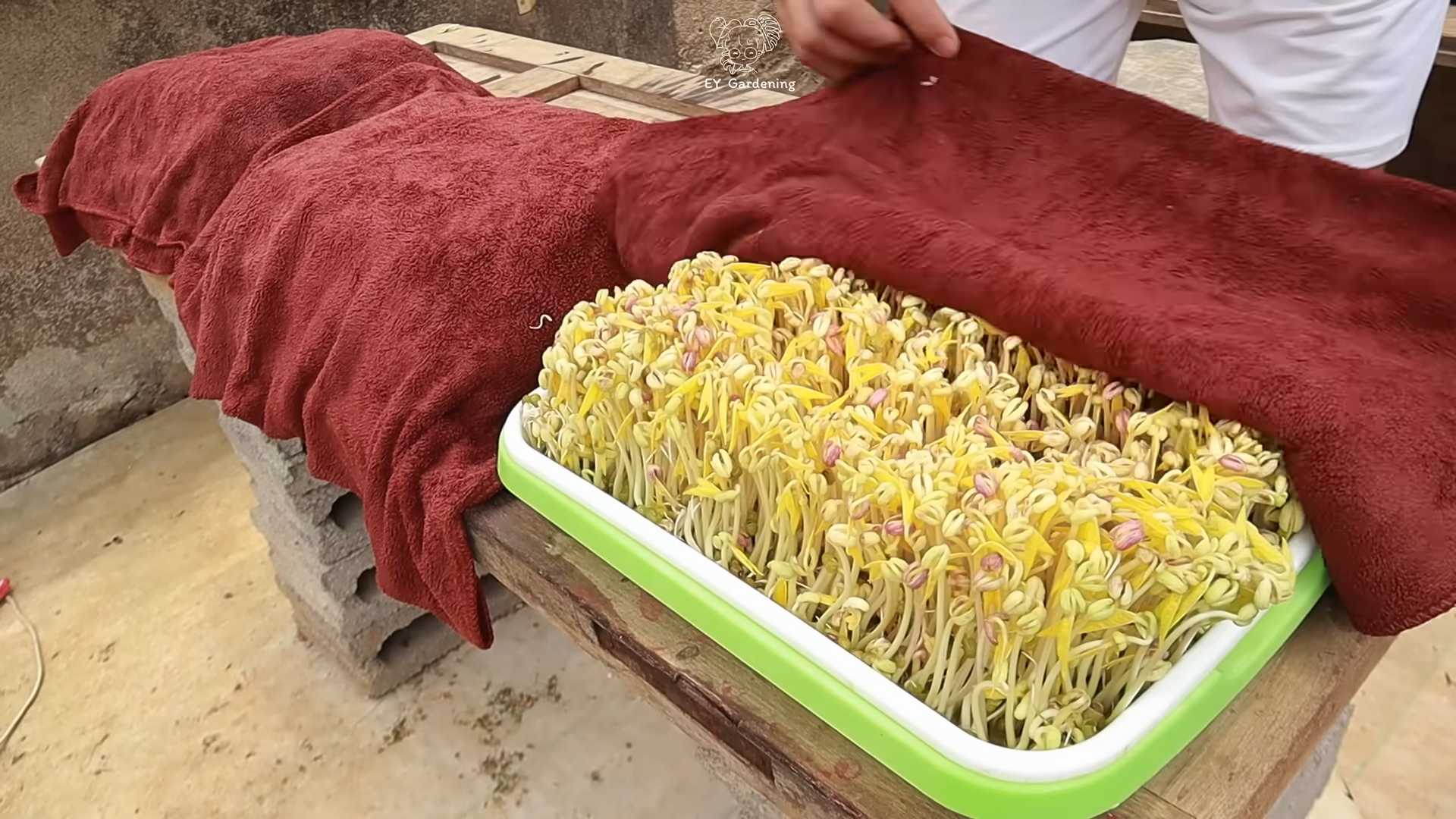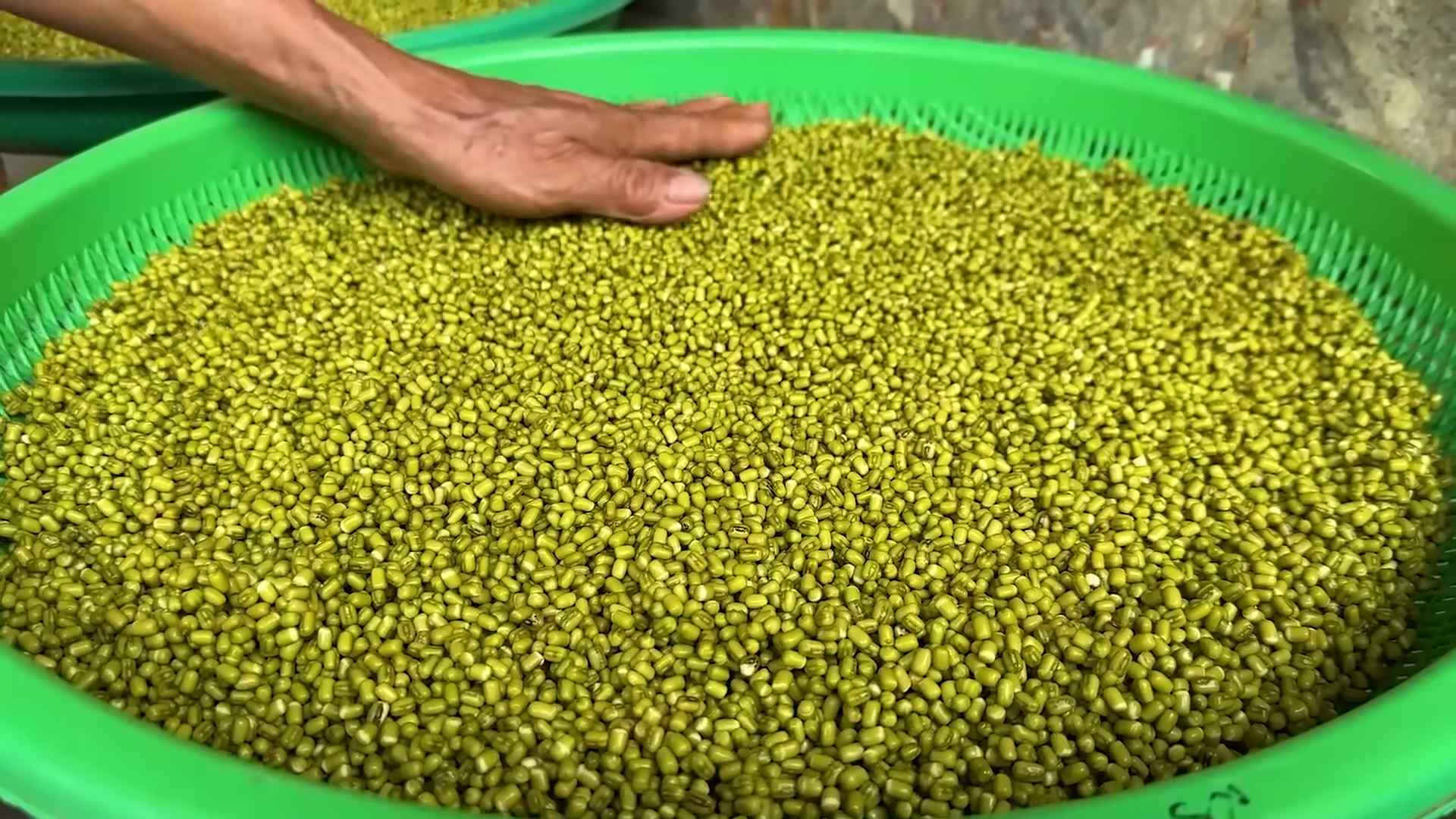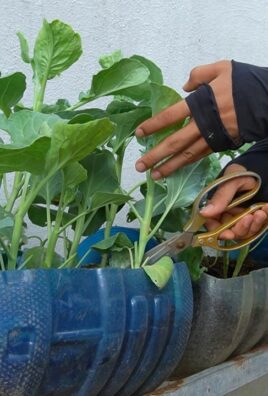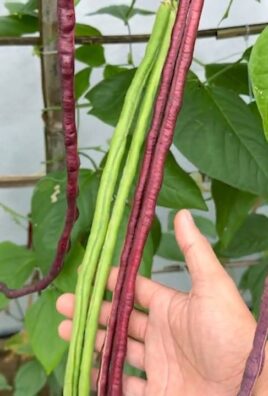Growing bean sprouts at home is easier than you might think, and I’m here to show you how! Forget those pricey trips to the grocery store for a handful of sprouts – you can cultivate your own fresh, crunchy goodness right in your kitchen.
Sprouting has a long and fascinating history, dating back thousands of years. Ancient cultures, particularly in Asia, recognized the nutritional powerhouses hidden within these tiny germinated seeds. They understood that sprouting dramatically increases the vitamin and mineral content, making them a valuable food source, especially during times of scarcity. Think of it as nature’s way of amplifying goodness!
But why should you bother with growing bean sprouts at home today? Well, beyond the historical significance, it’s incredibly practical. In today’s world, we’re all looking for ways to eat healthier, save money, and reduce our environmental impact. Sprouting ticks all those boxes! Plus, it’s a fun and rewarding project, especially for families. Imagine the satisfaction of sprinkling your own homegrown sprouts on salads, sandwiches, or stir-fries. It’s a simple way to add a burst of freshness and nutrients to your meals, and I’m excited to guide you through the process with these easy DIY tricks and hacks. Let’s get sprouting!

Growing Bean Sprouts at Home: A Simple DIY Guide
Hey there, fellow sprout enthusiasts! I’m so excited to share my tried-and-true method for growing delicious and nutritious bean sprouts right in your own kitchen. Forget those expensive store-bought sprouts – this DIY project is easy, affordable, and incredibly rewarding. Plus, you get the satisfaction of knowing exactly where your food comes from!
What You’ll Need
Before we dive in, let’s gather our supplies. The beauty of this project is that you probably already have most of these items lying around:
* **Beans:** Mung beans are the classic choice for bean sprouts, but you can also use adzuki beans, lentils, or even chickpeas. Just make sure they are whole, un-split, and intended for sprouting (check the packaging). I usually go for organic mung beans for the best flavor and peace of mind.
* **A Wide-Mouth Jar:** A quart-sized mason jar works perfectly. You can also use a clean glass or plastic container. The key is to have a wide opening for easy access and good air circulation.
* **Sprouting Lid or Cheesecloth:** You’ll need something to cover the jar and allow water to drain. A sprouting lid is ideal (they’re inexpensive and reusable), but a piece of cheesecloth secured with a rubber band will work just as well.
* **Water:** Filtered water is best, but tap water that’s been left to sit for a few hours to allow chlorine to dissipate is also fine.
* **A Dark Place:** Bean sprouts need darkness to grow properly. A cupboard, pantry, or even a covered box will do the trick.
* **A Bowl or Tray:** To catch any excess water that drains from the jar.
Preparing Your Beans
This is a crucial step, so pay close attention!
1. **Rinse the Beans:** Place your beans in a colander and rinse them thoroughly under cool running water. This removes any dirt, debris, or broken beans.
2. **Soak the Beans:** Transfer the rinsed beans to your jar. Add plenty of cool water – about three times the volume of the beans. They’ll expand as they soak.
3. **Soaking Time:** Let the beans soak for 8-12 hours, or even overnight. This rehydrates them and kickstarts the germination process. I usually soak mine before bed and they’re ready to go in the morning.
The Sprouting Process
Now for the fun part!
1. **Drain and Rinse:** After soaking, drain the water from the jar using your sprouting lid or cheesecloth. Rinse the beans thoroughly with fresh, cool water. This is important to prevent mold and bacteria growth.
2. **Invert and Drain:** Place the jar upside down in your bowl or tray at an angle. This allows excess water to drain out while still allowing air to circulate. I usually prop mine up against something to ensure good drainage.
3. **Darkness is Key:** Place the jar in your chosen dark location. Remember, darkness encourages the sprouts to grow long and white.
4. **Rinse and Drain (Twice a Day!):** This is the most important part of the entire process! Rinse and drain your sprouts twice a day – once in the morning and once in the evening. This keeps them hydrated and prevents them from drying out or becoming moldy. Use cool, fresh water each time.
5. **Repeat:** Continue rinsing and draining twice a day for 3-5 days, or until your sprouts reach your desired length. I personally like mine when they’re about 2-3 inches long.
Troubleshooting
Sometimes things don’t go exactly as planned. Here are a few common issues and how to fix them:
* **Mold:** If you see any fuzzy mold growing on your sprouts, discard the entire batch. Mold is a sign of contamination and can be harmful. To prevent mold, make sure you’re rinsing and draining your sprouts thoroughly twice a day. Good air circulation is also key.
* **Slow Growth:** If your sprouts are growing slowly, it could be due to a few factors. Make sure they’re in a dark enough location and that you’re rinsing them regularly. The temperature can also play a role – sprouts grow best in a cool environment (around 60-70°F).
* **Unpleasant Smell:** A strong, unpleasant smell is another sign of bacterial growth. Discard the sprouts and start over, paying extra attention to rinsing and draining.
* **Beans Not Sprouting:** If your beans aren’t sprouting at all, it could be that they’re old or damaged. Try using a fresh batch of beans from a different source.
Harvesting and Storing Your Sprouts
Congratulations! You’ve successfully grown your own bean sprouts. Now it’s time to harvest and enjoy them.
1. **Final Rinse:** Give your sprouts one last thorough rinse under cool water. This will remove any remaining bean hulls.
2. **Drain Well:** Drain the sprouts as much as possible. You can use a salad spinner to remove excess water.
3. **Storage:** Store your sprouts in an airtight container in the refrigerator. They’ll keep for about a week. I like to line the container with a paper towel to absorb any excess moisture.
Using Your Bean Sprouts
Now for the best part – eating your delicious, homegrown bean sprouts! They’re incredibly versatile and can be used in a variety of dishes.
* **Salads:** Add them to your favorite salads for a crunchy and nutritious boost.
* **Sandwiches and Wraps:** They add a great texture and flavor to sandwiches and wraps.
* **Stir-fries:** Toss them into stir-fries for a quick and easy way to add vegetables.
* **Soups:** They’re a great addition to soups, especially Asian-inspired soups like ramen or pho.
* **Spring Rolls:** Use them as a filling for fresh spring rolls.
* **Juicing:** Add a handful to your juicer for an extra dose of vitamins and minerals.
Tips and Tricks for Sprout-Growing Success
Here are a few extra tips to help you become a sprout-growing pro:
* Use High-Quality Beans: This is the most important factor for successful sprouting. Choose organic, whole beans specifically intended for sprouting.
* Maintain Good Hygiene: Always wash your hands thoroughly before handling your sprouts. This will help prevent contamination.
* Don’t Overcrowd the Jar: Use only enough beans to cover the bottom of the jar in a single layer. Overcrowding can lead to mold growth.
* Experiment with Different Beans: Once you’ve mastered mung bean sprouts, try experimenting with other types of beans and lentils. Each has its own unique flavor and texture.
* Adjust Rinsing Frequency: In hot weather, you may need to rinse your sprouts more than twice a day to keep them from drying out. In cooler weather, you may be able to get away with rinsing only once a day.
* Taste Test: Taste your sprouts regularly to check for bitterness or off-flavors. If they taste bitter, they may need to be rinsed more frequently.
* Enjoy the Process: Growing bean sprouts is a simple and rewarding project. Don’t be afraid to experiment and have fun!
Why Grow Your Own Bean Sprouts?
Besides being incredibly easy and affordable, growing your own bean sprouts offers a ton of benefits:
* Freshness: You can’t beat the taste of freshly grown sprouts. They’re so much more flavorful than store-bought sprouts.
* Nutrition: Bean sprouts are packed with vitamins, minerals, and enzymes. They’re a great source of protein, fiber, and antioxidants.
* Cost-Effective: Growing your own sprouts is much cheaper than buying them from the store.
* Sustainability: You’re reducing your carbon footprint by growing your own food.
* Educational: It’s a great way to learn about the life cycle of plants and where your food comes from.
* Fun: It’s a fun and rewarding project that the whole family can enjoy.
A Few More Thoughts
I’ve been growing my own bean sprouts for years, and I still get excited every time I see those little sprouts emerge. It’s such a simple and satisfying way to add fresh, healthy food to my diet. I hope this guide has inspired you to give it a try. Happy sprouting!

Conclusion
So, there you have it! Growing bean sprouts at home is not only incredibly easy and cost-effective, but it also provides you with a constant supply of fresh, nutritious sprouts right at your fingertips. Forget those limp, sad-looking sprouts from the grocery store – with just a few simple supplies and a little patience, you can cultivate vibrant, crunchy bean sprouts bursting with flavor and goodness.
This DIY trick is a must-try for several compelling reasons. First and foremost, you have complete control over the growing process. You know exactly what you’re eating, free from any unwanted additives or preservatives. This is especially important for those who prioritize organic and sustainable living. Secondly, the freshness factor is unparalleled. Imagine adding a handful of freshly harvested bean sprouts to your salad, stir-fry, or sandwich – the difference in taste and texture is remarkable. Finally, it’s incredibly rewarding to watch these tiny seeds transform into a thriving crop in just a few days. It’s a mini-gardening project that anyone can accomplish, regardless of their experience level.
But the fun doesn’t stop there! Feel free to experiment with different types of beans. Mung beans are the classic choice, but you can also try adzuki beans, lentils, or even chickpeas. Each variety offers a unique flavor profile and nutritional profile. You can also adjust the sprouting time to achieve your desired level of crunchiness. Some people prefer their sprouts shorter and more tender, while others like them longer and crispier.
Another exciting variation is to add a touch of spice to your bean sprouts. Consider adding a pinch of chili flakes or a few slices of ginger to the sprouting jar for a subtle kick. You can also experiment with different rinsing solutions, such as adding a splash of lemon juice or apple cider vinegar to help prevent mold growth and enhance the flavor.
We wholeheartedly encourage you to give this DIY trick a try. It’s a simple, satisfying, and healthy way to add a boost of nutrition to your diet. Plus, it’s a great conversation starter! Imagine serving a dish featuring your own homegrown bean sprouts – your friends and family will be impressed.
Don’t be afraid to experiment and find what works best for you. The beauty of this method is its adaptability. Once you master the basic technique, you can customize it to suit your preferences and needs.
We’re confident that you’ll be amazed by how easy and rewarding it is to grow your own bean sprouts at home. So, gather your supplies, follow our simple instructions, and get ready to enjoy a delicious and nutritious harvest.
And most importantly, we want to hear about your experience! Share your photos, tips, and variations in the comments section below. Let’s create a community of bean sprout enthusiasts and inspire others to embrace this simple and sustainable way of growing their own food. Happy sprouting!
Frequently Asked Questions (FAQ)
What kind of beans can I use for sprouting?
The most common and readily available bean for sprouting is the mung bean. However, you can also successfully sprout adzuki beans, lentils, chickpeas, and even some types of peas. Just be sure to use beans specifically intended for sprouting or cooking, as some ornamental beans can be toxic. Avoid using beans that have been treated with pesticides or fungicides. Experiment with different varieties to discover your favorite flavor and texture.
How long does it take to grow bean sprouts?
Typically, it takes between 3 to 5 days to grow bean sprouts at home. The exact time will depend on the type of bean, the temperature, and the humidity. Mung beans tend to sprout relatively quickly, while other varieties may take a bit longer. Keep an eye on your sprouts and harvest them when they reach your desired length and crunchiness.
What kind of container should I use for sprouting?
You can use a variety of containers for sprouting, including a mason jar, a sprouting jar with a mesh lid, or even a plastic container with holes drilled in the bottom for drainage. The key is to ensure good air circulation and drainage to prevent mold growth. A glass jar is a popular choice because it’s easy to clean and allows you to monitor the sprouting process.
How often should I rinse the bean sprouts?
It’s crucial to rinse your bean sprouts at least twice a day, preferably three times, with fresh, cool water. This helps to keep them hydrated, prevent mold growth, and remove any accumulated waste products. Be sure to drain the water thoroughly after each rinse to avoid waterlogging.
What if my bean sprouts start to smell bad?
A foul odor is a sign of bacterial contamination or mold growth. If you notice a bad smell, discard the entire batch of bean sprouts immediately. To prevent this, ensure you’re rinsing the sprouts frequently and thoroughly, using clean water, and providing adequate air circulation.
Can I eat the bean sprout roots?
Yes, the roots of bean sprouts are perfectly edible and nutritious. They are a natural part of the sprouting process and contribute to the overall flavor and texture.
How do I store bean sprouts?
Once your bean sprouts have reached your desired length, rinse them thoroughly and drain them well. Store them in an airtight container lined with a paper towel in the refrigerator. The paper towel will help to absorb excess moisture and keep the sprouts fresh for up to a week.
Are there any health benefits to eating bean sprouts?
Yes, bean sprouts are packed with nutrients, including vitamins, minerals, and antioxidants. They are a good source of protein, fiber, and enzymes, which can aid digestion and boost your immune system. They are also low in calories and fat, making them a healthy addition to any diet.
Can I grow bean sprouts in direct sunlight?
No, bean sprouts should be grown in a dark or dimly lit environment. Direct sunlight can cause them to become bitter and develop tough stems. A cupboard, a pantry, or a shaded corner of your kitchen are all suitable locations.
What if my bean sprouts aren’t sprouting?
If your bean sprouts aren’t sprouting, there could be several reasons. First, make sure your beans are viable and haven’t expired. Second, ensure that the temperature is warm enough (around 70-75°F is ideal). Third, check that you’re rinsing the sprouts frequently enough. Finally, make sure the beans are not overcrowded in the container.
Can I use tap water to rinse my bean sprouts?
Yes, tap water is generally safe to use for rinsing bean sprouts, as long as it’s clean and potable. However, if you’re concerned about the quality of your tap water, you can use filtered water instead.
Are there any risks associated with eating raw bean sprouts?
While generally safe, raw bean sprouts can sometimes harbor bacteria, such as Salmonella or E. coli. To minimize the risk of foodborne illness, it’s essential to rinse the sprouts thoroughly and store them properly. If you’re pregnant, elderly, or have a weakened immune system, it’s best to cook bean sprouts before eating them.
How can I prevent mold growth on my bean sprouts?
Preventing mold growth is crucial for successful bean sprouting. The key is to ensure good air circulation, frequent rinsing, and proper drainage. Avoid overcrowding the beans in the container, and use a clean container and water for each batch. Adding a splash of lemon juice or apple cider vinegar to the rinsing water can also help to inhibit mold growth.
Can I compost the leftover bean sprout hulls?
Yes, the leftover bean sprout hulls are a great addition to your compost pile. They are a good source of nitrogen and will help to enrich your compost.




Leave a Comment